Intro: Project Goals & Objectives, Overview
of Work, Advancing into the Past, Tools
of the Trade,
Participating.
Soldier Hut Rehabilitation:
Overview of Initial Work
One of the first steps was to put a halt on water damage. A major
part of this was to dig out the back logs of the huts which had become
buried in soil over the course of 30 plus years. The grade was returned
to its 1966 profile and stabilization efforts have begun.
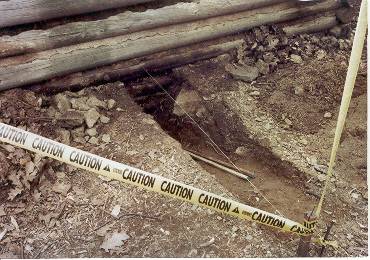
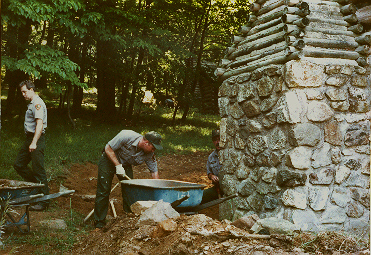
Trench dug by NPS Archaeologist revealing the depth of
fill from 30 years of erosion and composting leaves that were not removed
regularly. Morristown maintanence staff completed the regrading with
some assistance from volunteers. The bare soil was then covered with
biodegradeable erosion control matting and grass seed by the Park's Biology
Technician and Student Conservation Assistant.
The next steps were to work on the huts themselves. Black Locust
trees were cut for the base logs, and large diameter oak logs for making
shingles were bought from a local sawmill and given by Lewis Morris County
Park. Supply of oak, walnut, locust, and sassafrass that is
clear and straight continues to be a problem, but enough was found to get
started.

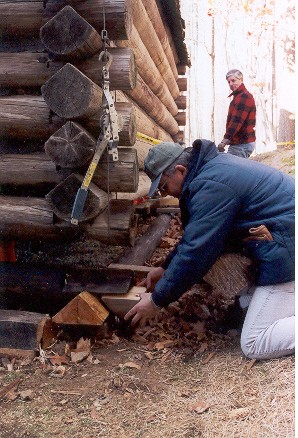
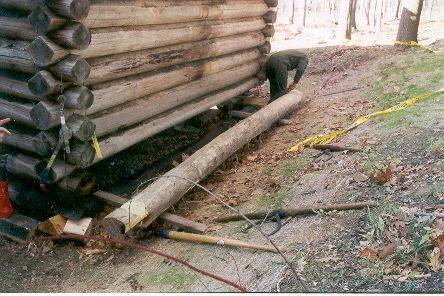
The first hut was lifted using mechanical jacks, and
four decayed logs were removed. Two logs that had slight rot to the
ends were repaired in place (middle photo). Four new logs of black locust
were cut and fit to each other and the logs above on the back and chimney
sides.
Roofing material was the next challenge. All of the historical
evidence supported the architect's original decision (in 1964) to use 4
foot long split shingles of oak. In the end, cedar had been used.
Only one supplier was found that could meet our needs in either (Lost Creek
Industries, Oregon). While that search was underway, we started making
our own shingles of oak.
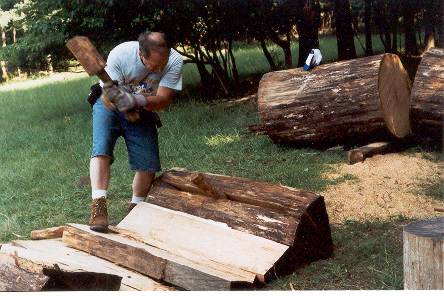

Although the reproduction 18th-century mauls and wedges
were not yet ready, sledge hammers & steel wedges along with wooden
'gluts' did the same job for us.
Once the billets were thin enough, they were then riven
into shingles. Right photo courtesy of Scott Shepherd
Before the first roof could be installed, the chinking mortar and chimney
lining had to be removed and replaced. As expected, the 'dechinking'
was hard, tedious work. Fortunately, the 2nd NJ Regiment stepped
in, and with a few others, did in one weekend what would have otherwise
been four weeks worth of work for the exhibit specialist if he had worked
alone.

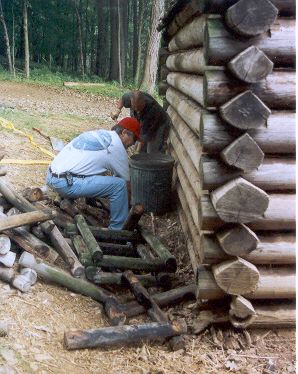
Using a combination of tools the mortar & lathe was
chipped, pounded and pulled out from between the logs.
The one problematic chimney and fireplace was taken
down as well. See deconstruction story about on the Morristown
NHP News page.
As the Fall of 2002 approached, two roofs were removed and it looked
like the first new roof would finally go on. However, additional
rot was found in the upper logs that had to be stablized. Further,
once the volunteers learned what we understood to be the original roofing
system of 1779, they encouraged us to show it in the exhibit huts if at
all possible. This required logs to be extended, but using a combination
of woodcraft and modern conservation techniques, it proved possible and
we forged ahead with it.

Prudential volunteers begin the process of coating the
cedar shingles for the first hut with a water repellent. (The oak
shingles will go on the next hut). They also helped install the new
roof pole and first row of shingles very much in the same manner the soldiers
at Morristown did in 1779-80..
| 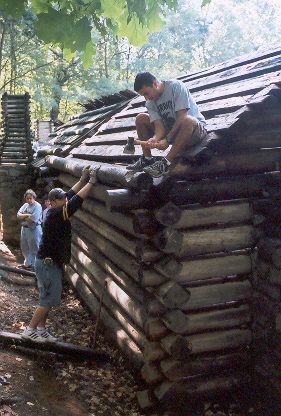 |
Site Content:
Project Goals & Objectives (intro)
Overview of Initial Work (page 1)
Advancing into the Past (page 2)
Tools of the Trade (page 3)
Participating at the Pennsylvania Line (page 4)
Contact: Mathew Grubel
Morristown National Historical Park (973) 539-2016
Note: The project is on indefinate hold as of Dec. 2003
You are still welcome to contact me via direct e-mail
here.
Revision Date: 7/19/2004










